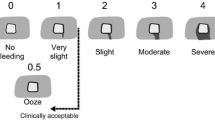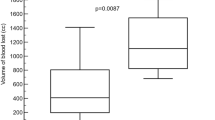Abstract
Background Management of post-operative bleeding has historically used topical bovine thrombin. However, possible harm through activation of coagulation inhibitors has encouraged investigation with other hemostatic agents. This study utilized a novel ordinal bleeding model to test whether a Gelfoam + human thrombin solution is superior at controlling bleeding when compared to Gelfoam + saline solution at different time intervals. Study design Four swine underwent open laparotomy after receiving unfractionated heparin. Twenty open liver biopsies were performed in each swine; ten biopsies treated with Gelfoam + human thrombin solution and 10 biopsies treated with Gelfoam + saline solution. Three, 6 min, and 12 min after the procedure, bleeding was objectively graded by a four-point model. Results There was a significant (P < 0.017), treatment effect on each success/failure outcome (success = bleeding score ≤ 1; failure = bleeding score > 1) at 3 (P < 0.001), 6 (P < 0.001), and 12 (P = 0.003) min, based on a 2 × 2 Fisher’s exact test. Similarly, there was a significant treatment effect on each success/failure outcome and four-point bleeding score based on a multiple logistic regression analysis controlling for pig, lesion weight, and initial bleeding taking into consideration repeated measures at three time points. Conclusions The results demonstrate a superior treatment effect for control of bleeding using human thrombin compared to a saline solution. Future studies should compare bovine thrombin versus human thrombins ability to control bleeding as well as the hazard of each in activating coagulation inhibitors.


Similar content being viewed by others
References
Seegers WH, Warner ED, Brinkhous KM, Smith HP (1939) The use of purified thrombin as an hemostatic agent. Science 89:85–86
Ofodile FA, Sadana MK (1991) The role of topical thrombin in skin grafting. J Natl Med Assoc 83(5):416–418
Sawada Y, Yotsuyanagi T (1992) A technique of haemostasis of the extremities after debridement of burn wounds. Burns 18(5):412–415
Kruger K, Zahringer M, Sohngen FD, Gossmann A, Schulte O, Feldmann C, Strohe D, Lackner K (2003) Femoral pseudoaneurysms: management with percutaneous thrombin injections—success rates and effects on systemic coagulation. Radiology 226(2):452–458
Strickler RB, Lane PK, Leffert JD, Rodgers GM, Shuman MA, Corash L (1989) Development of antithrombin antibodies following surgery in patients with prosthetic cardiac valves. Blood 73:1375–1380
Flaherty MJ, Henderson R, Wener MH (1989) Iatrogenic immunization with bovine thrombin: a mechanism for prolonged thrombin times after surgery. Ann Intern Med 111:631–634
Ortel TL, Mercer MC, Thames EH, Moore KD, Lawson JH (2000) Immunologic impact and clinical outcomes after surgical exposure to bovine thrombin. Ann Surg 233:88–96
Turner AS, Parker D, Egbert B, Maroney M, Armstrong R, Powers N (2002) Evaluation of a novel hemostatic device in an ovine parenchymal organ bleeding model of normal and impaired hemostasis. J Biomed Mater Res 63(1):37–47
Schelling G, Block T, Blancke E, Hammer C, Brendel W, Gokel M (1987) The effectiveness of a fibrinogen–thrombin–collagen-based hemostatic agent in an experimental arterial bleeding model. Ann Surg 205(4):432–435
Wiseman DM, Gottlick LE, Diamond MP (1992) Effect of thrombin induced hemostasis on the efficacy of an absorbable adhesion barrier. J Reprod Med 37(9):766–770
SAS Institute Inc., SAS/STAT Users Guide, Version 8. SAS, Cary, NC
Ortel TL, Charles LA, Keller FG, Marcom PK, Oldham HN Jr, Kane WH, Macik BG (1994) Topical thrombin and acquired coagulation factor inhibitors: clinical spectrum and laboratory diagnosis. Am J Hematol 45(2):128–135
Lundblad RL, Bradshaw RA, Gabriel D, Ortel TL, Lawson J, Mann KG (2004) A review of the therapeutic uses of thrombin. Thromb Haemost 91(5):851–860
Author information
Authors and Affiliations
Corresponding author
Rights and permissions
About this article
Cite this article
Adams, G.L., Manson, R.J., Hasselblad, V. et al. Acute in-vivo evaluation of bleeding with GelfoamTM plus saline and Gelfoam plus human thrombin using a liver square lesion model in swine. J Thromb Thrombolysis 28, 1–5 (2009). https://doi.org/10.1007/s11239-008-0249-3
Received:
Accepted:
Published:
Issue Date:
DOI: https://doi.org/10.1007/s11239-008-0249-3




